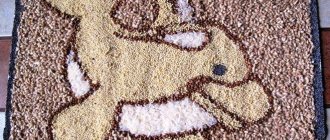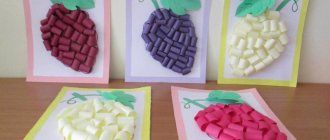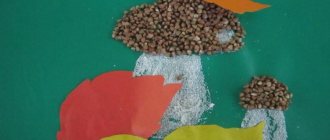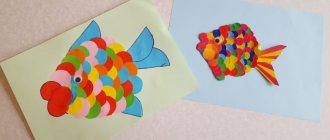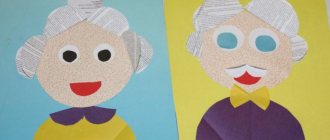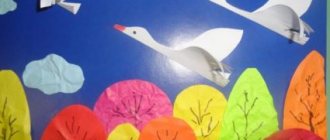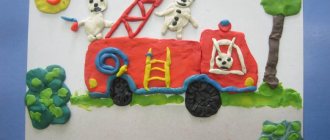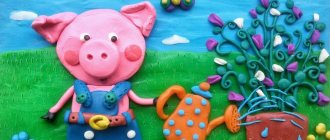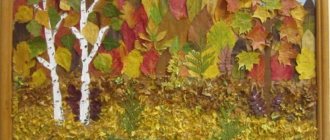From very early childhood, your child has the opportunity to see a wide variety of fruits and berries, which means that even then he begins to get acquainted with them. The child gradually remembers what this or that fruit looks like and the name of, then begins to determine the properties and qualities of fruits and berries.
In this article, the News portal “Vtemu.by” has prepared for you several options for voluminous paper applications on the theme of Fruits and Berries.
By doing arts and crafts with your child, you will not only be able to instill in him creative abilities, but also introduce him even closer to fruits and berries. In the process of creating an application, you can tell your child about the benefits of a particular fruit, adding thematic songs, riddles, proverbs and sayings, rhymes and jokes.
Well, now, let’s move on directly to the master classes on making Fruits and Berries paper appliques.
Required materials and tools
Even the smallest kids can make an applique out of paper, but with the help of adults. To implement such a craft, you need to show your personal imagination, or use ready-made instructions for children. You will also need some materials and tools:
- Cardboard (white or colored depending on the child’s wishes);
- Simple pencil (for sketching);
- Colored paper (single-sided, double-sided, velvet or corrugated is suitable);
- Glue for paper (for younger children, a glue stick is more suitable, but with PVA glue you should be careful not to spread it too much and thereby ruin the entire craft);
- Scissors (necessarily with rounded ends due to safety precautions);
- Felt-tip pens and markers (for additional decoration of the created work, since with the help of a little drawing of details, the application can sparkle with new colors and become more attractive).
Examples for the younger group
The leading place among handicraft lessons for children 2-3 years old on the topic of vegetables is canning.
At the preparatory stage, it is worth discussing with the children what vegetables they would like to see in their future creations.
After that, they can independently choose what they have voiced among pre-prepared templates and glue it to the base. A jar cut out of cardboard is suitable for it.
Examples for the middle group
From the age of three, children develop basic skills in using scissors. In this regard, you can complicate the tasks a little. A variety of themes using vegetables will work. This is both canning and a basket with the harvest.
For the second theme, you will need pre-prepared cardboard bases in the shape of baskets. If they are cut out of white cardboard, then it would be appropriate to invite the children to draw a pattern on them themselves. At the second stage, it is worth having a conversation on the topic of vegetables. A short description of each would be appropriate: its shape, color. It would also be useful to discuss their taste and beneficial properties.
For demonstration, you can show real vegetables brought from home. If you let babies touch them, they will also be able to feel and feel their texture.
After the introductory conversation, you can start cutting. It is worth once again focusing on shapes and sizes. To make the task easier, you can draw a sketch with a pencil.
It is worth understanding that few children at this age will be able to cut clearly along the contour. But despite this, a children's applique with figurative images can be assembled. In the next step, all that remains is to arrange all the blanks the way the child wants. And stick them with glue. Still life according to the master class for beginners is ready.
How to make an applique on the theme of vegetables for children in kindergarten
Making an applique on the theme of vegetables is not as difficult as it might initially seem. To implement such a small-scale project, you need to show a little imagination and stock up on the necessary materials.
To the younger group
The most relevant topic for applications in the younger group of kindergarten can easily be called the topic of canned vegetables. Before you begin this project, you need to discuss with your children the types of vegetables that they would like to see in their creation. This step will be the preparatory stage in the work.
You can ask your child what he knows about canning, thereby awakening interest in the project being carried out. It is necessary to give your child all the pre-prepared vegetable templates for appliqué. The basis for such an application can be the so-called “jar” prepared by the parent in advance. You can invite your child to arrange the parts on their own, and then evaluate how they are arranged. After the quality and visual perception of the layout has been assessed, you can begin gluing the parts onto the prepared base.
To the middle group
For children in the middle group of kindergarten, the task associated with the application on this topic can be slightly complicated.
To complete this level of crafts you will need colored paper, glue, scissors, as well as cardboard for the base, any color.
In the course of work, you must first understand what this picture will look like. The most practical and convenient option would be a “basket of vegetables.” To complete the entire project, it is necessary to prepare a basket template in advance and place it on a base presented in the form of cardboard.
You can draw a pattern on the basket that is typical for baskets.
The second step, together with the child, is to start cutting out vegetables of the required shapes and sizes. It is important to choose the shapes so that from afar and at first glance it is clear what item is in the basket. At this stage, you can talk to your child about vegetables.
The next step is to let your child arrange all the vegetables in the basket the way he likes. Only then can something be corrected and corrected.
Next we glue all the parts. You can add a few details near the basket to make the still life look complete.
To the senior group
If you need to make an applique for a child in an older group, then again you will have to complicate the work. Complications can be made by combining the appliqué with a mosaic, or by adding volume.
The option with a mosaic applique in the tear-off style will be considered in more detail.
The result will look unusual and will allow the child to fully engage his imagination and develop creative flight.
For this application you will need: cardboard, pencil, colored paper and glue.
The difficulty is that there will be no templates as such. It is enough just to draw on the base – cardboard – the silhouettes of those vegetables that the child wants to see in work.
Next, the drawn shapes are filled with tear-off squares of different sizes. The output should look something like this:
Similar work can be done by cutting parts for a mosaic, in which case the work will look more neat and take on clearer outlines. The work will look like a mosaic of individual colored fragments.
Examples for the older group
For older children, the application becomes more complicated due to the additional use of mosaics or adding volume. The following will demonstrate step-by-step instructions on how to make a vegetable applique in the tear-off style.
This craft looks unusual and provides the child with the opportunity to break out of the strict boundaries of cutting.
- A sheet of cardboard is used as a basis. On it, using a simple pencil, you can draw the silhouettes of any vegetables that you would like to see in your work.
- Take paper of the colors that are characteristic of the selected vegetables. For carrots - orange, for potatoes - brown, for tops - green, and so on. Each leaf is manually torn into small squares.
- The resulting pieces fill the space in the sketches. And they are glued on with glue.
- Ready!
Such work will look no less beautiful, but more accurately, if the parts for the mosaic are not torn by hand, but cut with scissors.
A voluminous craft is a little more difficult to make, but children can easily cope with it if they put in a little effort. Thus, a voluminous carrot can be created by folding a long orange strip of paper in half. Form a sharp corner on one side and leave the joint rounded on the opposite side. To which the green tail will remain glued.
You can also use another method. To do this, you need thick paper or cardboard rolled into a cone. Then cover the top with orange crepe paper.
And cover the round hole with green paper, in the center of which several short strips of green crepe paper will remain glued.
Carrot giraffe
This cute and easy-to-make giraffe will not leave anyone indifferent. Instead of carrots, you can use potatoes.
For this craft we need two large unequal carrots, toothpicks and three matches.
- From part of the larger carrot we make the body, from the remaining carrot we cut out the legs, from the smaller carrot we cut out the head and neck;
- We attach the neck and legs to the giraffe’s body with ordinary toothpicks. We attach the tail from the back; for this we use one of the prepared matches. This should be done so that only the head and very little straw remain visible;
- We cut out the head from the remaining part of the carrot and attach it to the neck with a toothpick. We also make horns from matches. Giraffe ears can also be cut from carrots, or you can get by with just the horns;
- The eyes can be easily made from cereals (for example, buckwheat) or pressed in with ordinary black beads. Giraffe spots can be easily made from paper or plasticine.
Related article: Children's sheepskin fur slippers: pattern and master class on sewing from old jeans
Our cute giraffe is ready!
Recommendations for Improving Collaboration
- When learning how to applique vegetables, it is important to follow each step consistently.
- It’s worth preparing all the required materials and templates in time so that you don’t have to be distracted by collecting what you need later.
- At the time of preparatory work, it is of considerable importance to familiarize children with works of art, as well as demonstrate drawings and photos of vegetable appliqués.
- With children, conducting classes in the form of a game is more suitable, since this way the children’s attention is drawn to what is happening and thereby develops emotional responsiveness.
- Adults should create a small plan so as not to lose track of the sequence of actions. Older children can follow the steps themselves.
- It is worth giving young creators more independent work so that they can express their imagination and learn how to realize it.
- During independent work, an adult is obliged to help the children, especially those who are not doing well.
- Upon completion of all the work, it is advisable to hold a collective exhibition, when everyone can look at someone else’s work and thus learn to enjoy the results of their own and other people’s work.
- In addition to individual work, the proposed ideas can also be implemented in group work, when everyone cuts out their own vegetable and glues it onto a large common base in the form of a plate, pan or cup.
- This approach is suitable for many applications. Especially on the topic of fruits.
Bulk vegetables and fruits
With one movement of the hand we turn strips of colored paper into voluminous fruits and vegetables: apples, carrots, cucumbers, pears, bunches of grapes, as the website krokotak.com advises.
It's easy to create a three-dimensional feel by layering multiple layers of paper on top of each other or folding them in half.
From identical silhouettes of fruits, by gluing them together, we create lantern crafts. Due to the multi-layering, we get almost real fruits and vegetables. Such crafts can be hung on a thread, placed in a basket, or glued to a base.
From many strips collected along the edge we make pumpkins, tomatoes, berries and apples. All round and ellipse-shaped fruits and vegetables are suitable here.
The strips, wound along the axis, can be turned into conical-shaped fruits and vegetables.
Vegetables and fruits can be made using special patterns. We cut them out, assemble them according to the pattern, and glue them along the edges.
